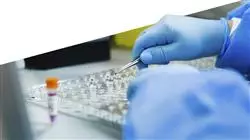University certificate
The world's largest faculty of nursing”
Introduction to the Program
A 100% online program, with which you will delve into health research and the benefits of technology in the improvement of health processes"

Emerging advances in ICTs have brought a global benefit to healthcare. Thanks to the incorporation of technology, healthcare services have become individualized and personalized processes. An example of this is mechanosynthesis, which aims to combat infectious diseases. At present, these types of conditions are the most common, and COVID has specified the application of clinical intervention techniques, but also of scientific research and, above all, of public communication to transmit the results of research at a global level.
In fact, the demand for healthcare professionals who know how to adapt to the 4.0 environment from their own profession is currently very high. TECH Global University has identified this request from clinical centers and therefore, has developed a complete and rigorous program in which graduates in Nursing, will be able to understand the procedures when using bibliographic resources, the management of health centers or the importance of working on health ethics in an environment in which professionals will influence the welfare of patients. This program aims to update the skills of health specialists so that they know how to interpret the bases of clinical trials and can put into practice the methodology of scientific research in their clinical practice.
This Health System. Clinical Medicine and Research has the collaboration of teachers who are experts in Health Sciences and who are working on projects that apply e-Health technologies. The students will be guided by them through a direct communication channel through which they will be able to resolve all questions about the subject. In this way, the specialists will obtain a complete and rigorous syllabus without having to travel or preset schedules, 100% online. This is a unique opportunity for health specialists to be at the height of the digital context that surrounds them and become much more competent professionals, once they have completed the Postgraduate diploma.
Join this Postgraduate diploma now and become a competitive professional directly involved in the management of health centers and their production"
This Postgraduate diploma in Health System. Clinical Medicine and Research contains the most complete and up-to-date scientific program on the market. The most important features include:
- The development of practical cases presented by experts in clinical research
- The graphic, schematic and practical contents with which it is designed provide clinical and practical information on those disciplines that are essential for professional practice
- Practical exercises where the self-assessment process can be carried out to improve learning
- Its special emphasis on innovative methodologies
- Theoretical lessons, questions to the expert, debate forums on controversial topics, and individual reflection assignments
- Content that is accessible from any fixed or portable device with an Internet connection
Deepen your knowledge in scientific research and transmit diagnoses with communicative keys that are adapted to the situation of your patients"
The program’s teaching staff includes professionals from the industry who contribute their work experience to this program, as well as renowned specialists from leading societies and prestigious universities.
The multimedia content, developed with the latest educational technology, will provide the professional with situated and contextual learning, i.e., a simulated environment that will provide immersive education programmed to learn in real situations.
This program is designed around Problem-Based Learning, whereby the professional must try to solve the different professional practice situations that arise during the course. For this purpose, students will be assisted by an innovative interactive video system created by renowned experts in the field of educational coaching with extensive experience.
Don't have Internet access 24 hours a day? Download the TECH reference guide and have a syllabus on your device that will guide you as a project manager"

In just 6 months, you will be able to master the Lean Management process and apply the tools to simplify work in the healthcare area"
Why study at TECH?
TECH is the world’s largest online university. With an impressive catalog of more than 14,000 university programs available in 11 languages, it is positioned as a leader in employability, with a 99% job placement rate. In addition, it relies on an enormous faculty of more than 6,000 professors of the highest international renown.

Study at the world's largest online university and guarantee your professional success. The future starts at TECH”
The world’s best online university according to FORBES
The prestigious Forbes magazine, specialized in business and finance, has highlighted TECH as “the world's best online university” This is what they have recently stated in an article in their digital edition in which they echo the success story of this institution, “thanks to the academic offer it provides, the selection of its teaching staff, and an innovative learning method aimed at educating the professionals of the future”
A revolutionary study method, a cutting-edge faculty and a practical focus: the key to TECH's success.
The most complete study plans on the university scene
TECH offers the most complete study plans on the university scene, with syllabuses that cover fundamental concepts and, at the same time, the main scientific advances in their specific scientific areas. In addition, these programs are continuously being updated to guarantee students the academic vanguard and the most in-demand professional skills. In this way, the university's qualifications provide its graduates with a significant advantage to propel their careers to success.
TECH offers the most comprehensive and intensive study plans on the current university scene.
A world-class teaching staff
TECH's teaching staff is made up of more than 6,000 professors with the highest international recognition. Professors, researchers and top executives of multinational companies, including Isaiah Covington, performance coach of the Boston Celtics; Magda Romanska, principal investigator at Harvard MetaLAB; Ignacio Wistumba, chairman of the department of translational molecular pathology at MD Anderson Cancer Center; and D.W. Pine, creative director of TIME magazine, among others.
Internationally renowned experts, specialized in different branches of Health, Technology, Communication and Business, form part of the TECH faculty.
A unique learning method
TECH is the first university to use Relearning in all its programs. It is the best online learning methodology, accredited with international teaching quality certifications, provided by prestigious educational agencies. In addition, this disruptive educational model is complemented with the “Case Method”, thereby setting up a unique online teaching strategy. Innovative teaching resources are also implemented, including detailed videos, infographics and interactive summaries.
TECH combines Relearning and the Case Method in all its university programs to guarantee excellent theoretical and practical learning, studying whenever and wherever you want.
The world's largest online university
TECH is the world’s largest online university. We are the largest educational institution, with the best and widest online educational catalog, one hundred percent online and covering the vast majority of areas of knowledge. We offer a large selection of our own degrees and accredited online undergraduate and postgraduate degrees. In total, more than 14,000 university degrees, in eleven different languages, make us the largest educational largest in the world.
TECH has the world's most extensive catalog of academic and official programs, available in more than 11 languages.
Google Premier Partner
The American technology giant has awarded TECH the Google Google Premier Partner badge. This award, which is only available to 3% of the world's companies, highlights the efficient, flexible and tailored experience that this university provides to students. The recognition as a Google Premier Partner not only accredits the maximum rigor, performance and investment in TECH's digital infrastructures, but also places this university as one of the world's leading technology companies.
Google has positioned TECH in the top 3% of the world's most important technology companies by awarding it its Google Premier Partner badge.
The official online university of the NBA
TECH is the official online university of the NBA. Thanks to our agreement with the biggest league in basketball, we offer our students exclusive university programs, as well as a wide variety of educational resources focused on the business of the league and other areas of the sports industry. Each program is made up of a uniquely designed syllabus and features exceptional guest hosts: professionals with a distinguished sports background who will offer their expertise on the most relevant topics.
TECH has been selected by the NBA, the world's top basketball league, as its official online university.
The top-rated university by its students
Students have positioned TECH as the world's top-rated university on the main review websites, with a highest rating of 4.9 out of 5, obtained from more than 1,000 reviews. These results consolidate TECH as the benchmark university institution at an international level, reflecting the excellence and positive impact of its educational model.” reflecting the excellence and positive impact of its educational model.”
TECH is the world’s top-rated university by its students.
Leaders in employability
TECH has managed to become the leading university in employability. 99% of its students obtain jobs in the academic field they have studied, within one year of completing any of the university's programs. A similar number achieve immediate career enhancement. All this thanks to a study methodology that bases its effectiveness on the acquisition of practical skills, which are absolutely necessary for professional development.
99% of TECH graduates find a job within a year of completing their studies.
Postgraduate Diploma in Health System. Clinical Medicine and Research
The healthcare system is one of the fundamental pillars of any modern society, and its proper functioning is essential to ensure the health and welfare of the population. In this context, the Postgraduate Diploma in Health System. Clinical Medicine and Research designed by TECH Global University is a unique opportunity for those who wish to gain profound knowledge of the health system and its implications in clinical medicine and research. This postgraduate program focuses on the study of the healthcare system, from its most technical and organizational aspects to its ethical and legal implications. Through this program, participants will be able to acquire a complete specialization in the functioning of the healthcare system, its objectives and its challenges.
This postgraduate program is particularly relevant in a context where the healthcare system has gained great importance worldwide due to the COVID-19 pandemic. The Postgraduate Diploma in Health System. Clinical Medicine and Research from TECH Global University provides the necessary tools and knowledge to understand the health system, its functioning and the necessary measures to ensure public health. Enroll in this Postgraduate Diploma in Health System. Clinical Medicine and Research from TECH Global University and become a reference in your field!







